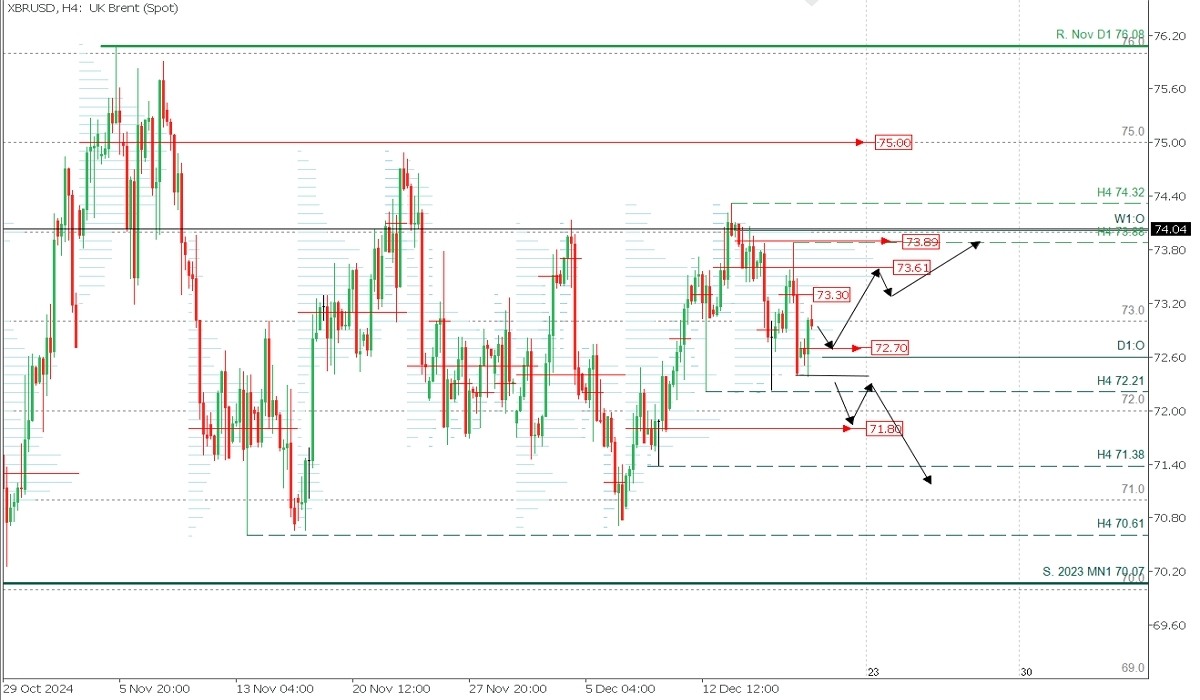Fundamental Analysis
Macro Factors and Monetary Policy
U.S. Crude Reserves and Interest Rates:
- Crude oil reserves in the U.S. have been decreasing since October, indicating healthy domestic demand and providing support to oil prices.
- The Federal Reserve cut interest rates by 25 basis points for the third time on December 18 but signaled a slower pace of future cuts, strengthening the dollar. This could put downward pressure on oil prices by making it more expensive in international markets.
Global Demand and China
Weakness in China:
- China's demand, a key driver for the crude market, remains uncertain due to weakening consumption. This limits the chances of a significant price rebound.
- Analysts highlight that negative economic data from China has kept Brent and West Texas Intermediate (WTI) prices within a narrow range.
OPEC+ Production and Policies
Postponement of Production Increases:
- OPEC+ has delayed its gradual production increases until April 2025 to stabilize prices amid weak demand and rising supply from non-allied countries such as Brazil and Argentina.
- However, current crude prices reflect an oversupplied market, which may hinder OPEC+'s efforts to sustain higher prices.
Key Insights:
- Fed policies and dollar strength will be critical for crude oil in 2025. A stronger dollar will likely cap oil price gains.
- China's demand in the global market and OPEC+'s strategy will be key factors keeping prices in check.
- Supply from non-OPEC+ countries will remain a significant source of competition.
Technical Analysis
XBRUSD, H4

- Supply Zones (Sell): 73.30, 73.61, and 73.89
- Demand Zones (Buy): 72.70 and 71.80
Recent price consolidation over the past few weeks, and particularly in recent days, necessitates consideration of two possible scenarios:
- Bearish Continuation:
This will occur if the price breaks below the volume concentration area near 72.70 during the early sessions, moving past the 72.21 support toward the uncovered buyer POC at 71.80. A more moderate bullish reaction here would signal further declines toward 71.38, 71.00, 70.61, and eventually the 2023 support level at 70.00.
- Bullish Bias:
A bullish scenario will activate with an aggressive rebound from the demand zones at 72.70 or even 71.80, pushing above 73.00 and 73.30. The target will be a breakout of the supply zone between 73.61 and 73.89, aiming for the 74.32 resistance and the next supply zone at 75.00.
Technical Summary
Bearish Scenario:
- Sell below 73.30/73.00 with targets at 72.21, 72.00, 71.80, 71.38, and 71.00.
Bullish Scenario:
- Buy above 72.60 (following the formation and confirmation of a PAR*) with targets at 73.60, 73.90, 74.00, 74.32, and 75.00 in extension.
Always wait for the formation and confirmation of a Pattern of Exhaustion/Reversal (PER) on the M5 timeframe, as taught here:
https://t.me/spanishfbs/2258 before entering any trade in the key zones we’ve outlined.
Uncovered POC Explanation:
- POC (Point of Control): The level or zone with the highest volume concentration.
- If a prior bearish movement originated from this level, it is considered a sell zone and acts as resistance.
- Conversely, if a bullish impulse occurs, it is considered a buy zone, usually located at lows and acting as support.
@2x.png?quality=90)

